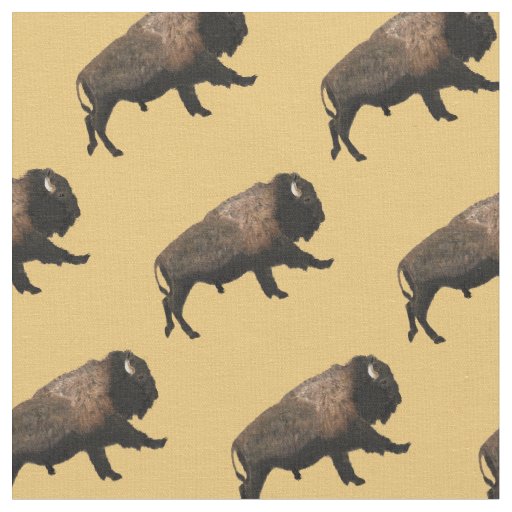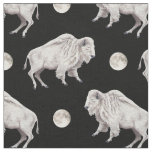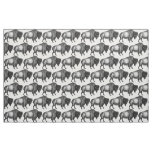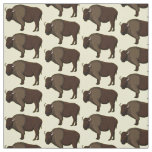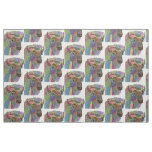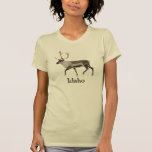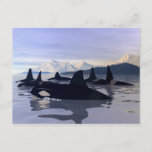Galloping Bison Fabric
A digital painting of the American bison, or buffalo, superimposed on a background color suggesting brain-tanned leather. You may choose another background color. The bison (Bison bison), the largest land mammal in North America, is considered a keystone species: they once roamed the continent in great herds, and their grazing pressure helped shape the ecology of the Great Plains. Two subspecies or ecotypes have been described: the plains bison (Bison bison bison), smaller in size and with a more rounded hump, and the wood bison (Bison bison athabascae) – the larger of the two and having a taller, square hump. The bison is a relative newcomer to North America, having originated in Eurasia and migrated over the Bering Strait About 10,000 years ago it replaced the steppe bison (Bison priscus), a previous immigrant that was much larger. It is thought that the steppe bison became extinct due to a changing ecosystem and hunting pressure following the development of the Clovis point and related technology, and improved hunting skills. During this same period, other megafauna vanished and were replaced to some degree by immigrant Eurasian animals that were better adapted to predatory humans. The extant bison, technically a dwarf form, was one of these animals. There were once an estimated 20-30 million bison, also referred to as buffalo, roaming North America. Their range once roughly comprised a triangle between the Great Bear Lake in Canada's far northwest, south to the Mexican states of Durango and Nuevo León, and east along the western boundary of the Appalachian Mountains. The first thoroughfares of North America, except for the time-obliterated paths of mastodon or musko, were the traces made by bison and deer in seasonal migration and between feeding grounds and salt licks. Many of these routes, hammered by countless hoofs instinctively following watersheds and the crests of ridges in avoidance of lower places' summer muck and winter snowdrifts, were followed by Native Americans and were invaluable to explorers.. The term "buffalo" may be considered a misnomer for this animal, as it is only distantly related to either of the two "true buffalo," the Asian water buffalo and the African buffalo. However, "bison" is a Greek word meaning ox-like animal, while "buffalo" originated with the French fur trappers who called these massive beasts bœufs, meaning ox or bullock – so both names, "bison" and "buffalo," have a similar meaning. In reference to this animal, the term "buffalo," which dates to 1635, has a much longer history than the term "bison," which was first recorded in 1774.The American bison is more closely related to the wisent or European bison. Unregulated shooting of bison, which culminated in mass slaughters during the 1870s, reduced the population to 1,091 in 1889. Today, approximately 500,000 bison live across North America. Most are not pure bison but rather have been cross-bred with cattle in the past and are raised as livestock on ranches. Fewer than 30,000 bison are in conservation herds, and fewer than 5,000 are free-ranging and disease-free. Today bison are ecologically extinct throughout most of their historic range, except for a few national parks and other small wildlife areas. Yellowstone National Park has the largest population of free-roaming plains bison (about 4,000), and Wood Buffalo National Park has the largest population of free-roaming wood bison (about 10,000). A bison has a shaggy, long, dark brown winter coat, and a lighter weight, lighter brown summer coat. The winter coat is so thick and well insulated that snow can cover its backs without melting. Male bison are slightly larger than females. Plains bison typically weigh from 700 to 2,200 lbs. The heaviest wild bull ever recorded weighed 2,800 lbs. When raised in captivity and farmed for meat, the bison can grow unnaturally heavy and the largest semi-domestic bison weighed 3,800 lbs. The heads and forequarters are massive, and both sexes have short, curved horns that can grow up to 2 feet long, which they use in fighting for status within the herd and for defense. Bison are herbivores, grazing on the grasses and sedges of the North American prairies. Their daily schedule involves two-hour periods of grazing, resting and cud chewing, then moving to a new location to graze again. This regular motion ensures that bison seldom overgraze an area. Bison often rub and roll on the ground creating shallow, saucer-like depressions called wallows. Bison roll in wallow, wet or dry, covering themselves with dust or mud. Past explanations and current hypotheses suggested for wallowing behavior include grooming behavior associated with shedding, male-male interaction (typically rutting behavior), social behavior for group cohesion, play behavior, relief from skin irritation due to biting insects; reduction of ticks and lice; and thermoregulation. Wallows were once a common feature of the plains. In winter, bison can dig through deep snow with their heads to reach the vegetation below. Bison have poor eyesight, but have acute hearing and an excellent sense of smell. Bison can reach speeds of up to 35 mph. Bison have a life expectancy of approximately 15 years in the wild and up to 25 years in captivity. Bison mate in late spring and summer in more open plain areas. During fall and winter, bison tend to gather in more wooded areas. During this time, bison partake in horning behaviors. They will rub their horns against trees, young saplings and even telephone poles. Aromatic trees like cedars and pine seem to be preferred. Horning appears to be associated with insect defense as it occurs most often in the fall when the insect population is at its highest. Cedar and pines emit an aroma after bison horn them and this seems to be used as a deterrent for insects. While often secure from predation due to their size and strength, in some areas, bison are regularly predated by wolves. Wolf predation typically peaks in late spring and early summer, with attacks usually being concentrated on cows and calves. Observations have shown that wolves more actively target herds with calves than those without. The length of a predation episode varies, ranging from a few minutes to over nine hours. Bison display five apparent defense strategies in protecting calves from wolves: running to a cow, running to a herd, running to the nearest bull, running in the front or center of a stampeding herd, and entering water bodies such as lakes or rivers. When fleeing wolves in open areas, cows with young calves take the lead, while bulls take to the rear of the herds, to guard the cows' escape. Bison typically ignore wolves not displaying hunting behavior. Wolf packs specializing in bison tend to have a greater number of males, as their superior size compared to the females allows them to wrestle their prey to the ground more effectively. The grizzly bear can also pose a threat to calves and sometimes adult bison, especially infirm specimens. Bison were a keystone species, whose grazing pressure was a force that shaped the ecology of the Great Plains as strongly as periodic prairie fires and which were central to the lifestyle of Native Americans of the Great Plains. However, there is now some controversy over their interaction. "Hernando De Soto's expedition staggered through the Southeast for four years in the early 16th century and saw hordes of people but apparently did not see a single bison," Charles C. Mann wrote in 1491: New Revelations of the Americas Before Columbus. Mann discussed the evidence that Native Americans not only created (by selective use of fire) the large grasslands that provided the bison's ideal habitat but also kept the bison population regulated. In this theory, it was only when the original human population was devastated by wave after wave of epidemic (from diseases of Europeans) after the 16th century that the bison herds propagated wildly. In such a view, the seas of bison herds that stretched to the horizon were a symptom of an ecology out of balance, only rendered possible by decades of heavier-than-average rainfall. Other evidence of the arrival circa 1550–1600 AD in the savannas of the eastern seaboard includes the lack of places which southeast natives named after buffalo. Bison were the most numerous single species of large wild mammal on Earth. What is not disputed is that before the introduction of horses, bison were herded into large chutes made of rocks and willow branches and then stampeded over cliffs. These buffalo jumps are found in several places in the U.S. and Canada, such as Head-Smashed-In Buffalo Jump. Large groups of people would herd the bison for several miles, forcing them into a stampede that would ultimately drive many animals over a cliff. The large quantities of meat obtained in this way provided the hunters with surplus, which was used in trade. Later, when Plains Indians obtained horses, it was found that a good horseman could easily lance or shoot enough bison to keep his tribe and family fed, as long as a herd was nearby. The bison provided meat, leather, sinew for bows, grease, dried dung for fires, and even the hooves could be boiled for glue. When times were bad, bison were consumed down to the last bit of marrow. The only continuously wild bison herd in the United States resides within Yellowstone National Park.[23] Numbering between 3,000 and 3,500, the Yellowstone Park Bison Herd is descended from a remnant population of 23 individual 'mountain' bison that survived the mass slaughter of the 19th century by hiding out in the Pelican Valley of Yellowstone Park. In 1902, a captive herd of 21 plains bison was introduced to the Lamar Valley and managed as livestock until the 1960s, when a policy of natural regulation was adopted by the park. The end of the ranching era and the onset of the natural regulation era set into motion a chain of events that have led to the bison of the Yellowstone Park Bison Herd migrating to lower elevations outside the park in search of winter forage. The presence of wild bison in Montana is perceived as a threat to many cattle ranchers, who fear that the small percentage of bison that carry brucellosis will infect livestock and cause cows to abort their first calves. However, there has never been a documented case of brucellosis being transmitted to cattle from wild bison. The management controversy that began in the early 1980s continues to this day, with advocacy groups arguing that the Yellowstone Park Bison Herd should be protected as a distinct population segment under the Endangered Species Act. Bison are now raised for meat and hides. The majority of bison in the world are being raised for human consumption. Bison meat is lower in fat and cholesterol than beef,a fact which has led to the development of beefalo, a fertile crossbreed of bison and domestic cattle. In 2005, about 35,000 bison were processed for meat in the U.S., with the National Bison Association and USDA providing a "Certified American Buffalo" program with birth-to-consumer tracking of bison via RFID ear tags. There is even a market for kosher bison meat; these bison are slaughtered at one of the few kosher mammal slaughterhouses in the U.S., and the meat is then distributed nationwide. A proposal known as Buffalo Commons has been suggested by a handful of academics and policymakers to restore large parts of the drier portion of the Great Plains to native prairie grazed by bison. Proponents argue that current agricultural use of the shortgrass prairie is not sustainable, pointing to periodic disasters, including the Dust Bowl, and continuing significant human population loss over the last 60 years. However, this plan is opposed by some who live in the areas in question.


